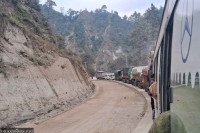Opinion
The trinity trap
A presidential government is, perhaps, the best option for Nepal
Ram C Acharya
Worse would be if the parliamentary system is combined with two other components, a setup with of a large number of political parties and the proportional representative electoral (PR) system. The mix of the three will continuously create political deadlocks and impose insurmountable costs to the country. The impasse that would emerge from their presence would further degrade public institutions and foster corruption—the two deeply ingrained vicious enemies of Nepal’s economic and social development.
A political system can function only if two of the elements in the trio, not all three, are present. Given that there are going to be more than two parties in Nepal, and that the PR system is required to address the goal of political inclusion, the constitution should not adopt the parliamentary form of government. In this case, the presidential system is the only viable option.
Turbulent coalitions
Nepal has 127 registered political parties. In the second Constituent Assembly (CA) elections, 120 parties contested for the 240 seats, fielding 5,010 candidates under the first-past-the-post (FPTP) system—where the candidate receiving more votes than any other wins the election. Ten of the parties were able to win seats but no party could win a clear majority. As 335 CA members were selected under the proportional representation system, seats were even more thinly distributed among now 31 parties. The largest party currently has 34 percent of the seats; the second largest party has 30 percent, third 14 percent, fourth 5 percent and so on.
With so many parties and a mixed-combination of FPTP and PR-electoral system, it is hard to envision a party to be in majority, a condition necessary to avoid political stalemate and wrangling in a parliamentary system. Under this system, a leader of the party that wins the majority of seats in parliament automatically becomes the prime minister and is both the head of the executive branch of the government and the leader of the legislature. In case of no clear majority by a single party, a government can be formed only if a party can muster support
from other parties.
Nepal’s history is a living example of how difficult and unproductive the exercise of building a coalition government can be. Take the case of the first CA, where the largest party had 38 percent of the seats. We witnessed the frequent rise and fall of governments without any convincing reason. Even now, the coalition of the ruling parties only seems strong. A coalition government will stand only as long as the constituent parties find the arrangement beneficial; if the situation turns adverse, new coalitions emerge.
The country can be saved from this political quagmire only by adopting the presidential system, where a directly-elected president is the head of the state and the head of the executive, and chooses her executive team from among the citizens. The legislative branch will not have the chance to coalesce and meddle with the executive; it has to focus on its prescribed duty of making laws.
Unique to Nepal
There is a reason why almost none of the developed countries adopt the trio. Either they have none, or at most they have two. The US has none; instead it has two parties, FPTP electoral system and a presidential form of government. The UK, Canada and India do not adopt the PR system. Twenty-one of the 28 countries, in Western Europe, excluding the UK, follow the PR system but only three of them are parliamentary republics with few political parties.
Among them, Germany is the only federal country to have both the PR and parliamentary systems. But, there are fundamental differences between Germany and Nepal. First, German politics is dominated by two strong parties. Second, the head of the states and the government in Germany are chosen by direct and secret votes in parliament, which is different from what Nepal intends to adopt— an open and party-line voting.
It’s not wrong to be unique—to have Nepal’s own system—but what is needed is an innovative, not a wrong, mix of alternatives. To have a workable system, Nepal must give up one of the elements in the trio.
There is nothing much that one can do with respect to the number of political parties in Nepal. If the political parties were serious about representing peoples’ agendas, most of them would have consolidated into one by now. But in Nepal, where peoples’ suffering seems to be the least concern of the parties, it is hard to see parties merging for a better cause.
Similarly, both the FPTP and PR electoral systems have advantages and disadvantages. In Nepal’s case, however, since the PR can address the issue of political exclusion of the marginalised groups, the mixed electoral system is essential for building an inclusive society.
Only saviour
So among the three in the trio, Nepal should give up the parliamentary system. But, ironically, it seems to be upheld by consensus. The UCPN (Maoist), which argued strongly for a presidential system in its election manifesto, seems to be abandoning it in its bid for ethnic federalism. The Maoists could have been able to garner support from the public for the presidential system, but it chose to put this demand under the shadow of the 10-province federal state.
The Nepali Congress and CPN-UML are never tired of making false arguments—including that the presidential system may lead to dictatorship—in favour of the parliamentary system. The real reason for opposing the presidential system, however, is the ministerial berths—and the power and prestige that emanate from them—that some of the politicians consider as their life-long entitlements in a parliamentary system. They worry that these positions of power may cease to exist for them in a presidential form of government.
Acharya is a Canada-based economist who conducts research on economic policies and can be reached at [email protected]




 5.14°C Kathmandu
5.14°C Kathmandu












